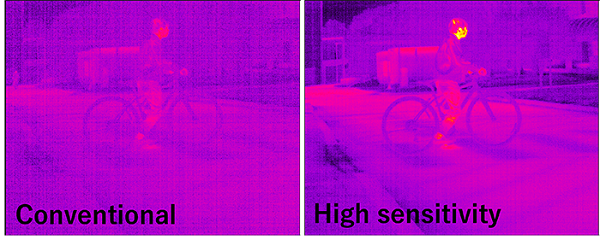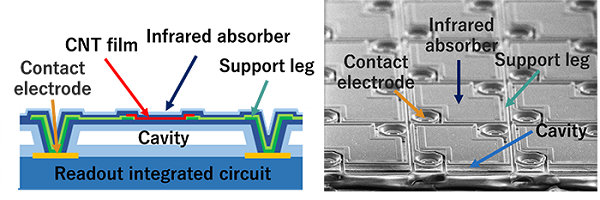NEC Develops the World's First Highly Sensitive Uncooled Infrared Image Sensor Utilizing Carbon Nanotubes
NEC Corporation has succeeded in developing the world's first high-sensitivity uncooled infrared image sensor that uses high-purity semiconducting carbon nanotubes (CNTs) in the infrared detection area. This was accomplished using NEC’s proprietary extraction technology. NEC will work toward the practical application of this image sensor in 2025.
Infrared image sensors convert infrared rays into electrical signals to acquire necessary information, and can detect infrared rays emitted from people and objects even in the dark. Therefore, infrared image sensors are utilized in various fields to provide a safe and secure social infrastructure, such as night vision to support automobiles driving in the darkness, aircraft navigation support systems and security cameras.
There are two types of infrared image sensors, the "cooled type," which operates at extremely low temperatures, and the "uncooled type," which operates near room temperature. The cooled type is highly sensitive and responsive, but requires a cooler, which is large, expensive, consumes a great deal of electricity, and requires regular maintenance. On the other hand, the uncooled type does not require a cooler, enabling it to be compact, inexpensive, and to consume low power, but it has the issues of inferior sensitivity and resolution compared to the cooled type.
(Left) Electron micrograph and image of single-walled CNTs, (Right) Atomic microscope image of a high-purity semiconducting CNT film.
(Left) Device structure, (Right) Photograph of CNT infrared array device.
In 1991, NEC discovered CNTs for the first time in the world and is now a leader in research and development related to nanotechnology. In 2018, NEC developed a proprietary technology to extract only semiconducting-type CNTs at high purity from single-walled CNTs that have a mixture of metallic and semiconducting types. NEC then discovered that thin films of semiconducting-type CNTs extracted with this technology have a large temperature coefficient of resistance (TCR) near room temperature.
The newly developed infrared image sensor is the result of these achievements and know-how. NEC applied semiconductor-type CNTs based on its proprietary technology that features a high TCR, which is an important index for high sensitivity. As a result, the new sensor achieves more than three times higher sensitivity than mainstream uncooled infrared image sensors using vanadium oxide or amorphous silicon.
The new device structure was achieved by combining the thermal separation structure used in uncooled infrared image sensors, the Micro Electro Mechanical Systems (MEMS) device technology used to realize this structure, and the CNT printing and manufacturing technology cultivated over many years for printed transistors, etc. As a result, NEC has succeeded in operating a high-definition uncooled infrared image sensor of 640 x 480 pixels by arraying the components of the structure.
Part of this work was done in collaboration with Japan’s National Institute of Advanced Industrial Science and Technology (AIST). In addition, a part of this achievement was supported by JPJ004596, a security technology research promotion program conducted by Japan’s Acquisition, Technology & Logistics Agency (ATLA).
Going forward, NEC will continue its research and development to further advance infrared image sensor technologies and to realize products and services that can contribute to various fields and areas of society.



It is "cool" that NEC has made a sort of microbolometer array from CNTs. The image in this post, though, does not seem to be as good as the infrared microbolometer in my 2013 vehicle. I remember taking a picture of a bicyclist back then off the display in the car and it seemed more sensitive than this picture. Maybe it is just adjustment of contrast in the image, or the weird purple tone applied to the raw monochrome image that microbolometers produce after non-uniformity correction. Unfortunately, infrared cameras are still not very common in cars, and quite expensive delta-cost when they are. Maybe NEC will change that.
ReplyDeleteThis is a case of improperly applied NUC, if you ignore the purple tone. Even the conventional (assuming traditional material microbolometer) has column, row and per pixel noise.
DeleteEric, here is a company that intends put thermal cameras on a lot of cars - owlai.us - (Disclaimer - I am doing some work for Owl). You can see how it is going on their YouTube channel - https://www.youtube.com/@owlautonomousimaging. They should probably be added to the ecosystem.
ReplyDelete